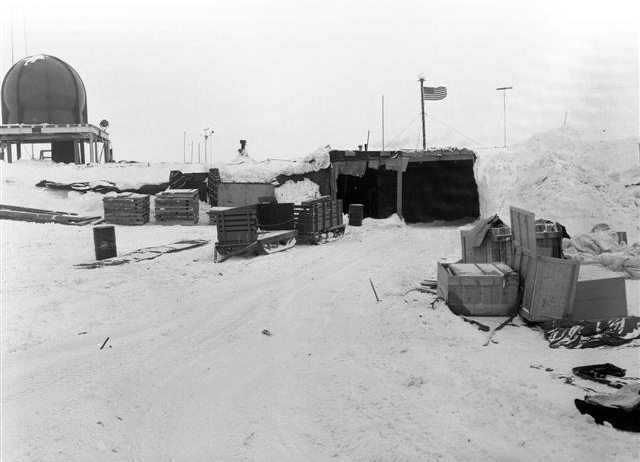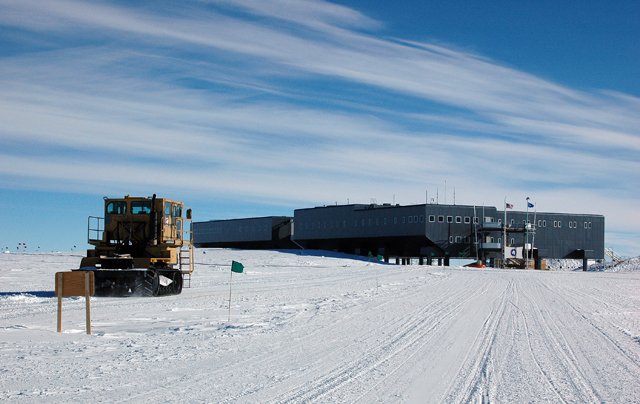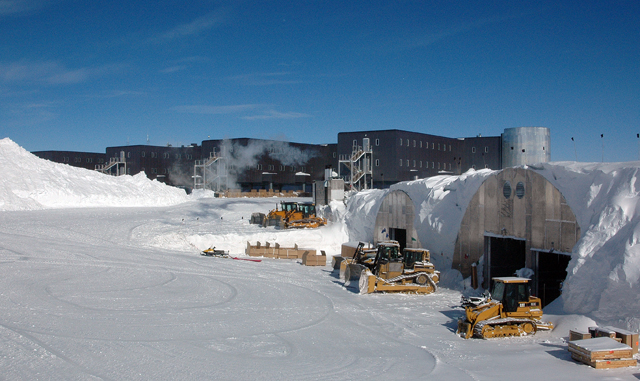Page 2/2 - Posted February 25, 2011
Veteran Seabees never expected Old Pole to survive so longThe T-5 structures were 10-foot-high by two-foot-wide panels, held together with steel wedges clips on both the interior and exterior walls. The roofs were flat. Eight-foot-high plywood structures, called Top Hats, were added to the top of the buildings to help displace the snow loads on the roofs and provide access as the snow piled up. Most of these buildings ended up with two layers of Top Hats. The Challenger had busted through two Top Hats and into the old communications T-5 building. The project to demolish Old Pole began in November with a ground-penetrating radar scan of the whole area. The Cold Regions Research & Engineering Laboratory (CRREL) All the building corners were flagged on the snow surface, and all the dangerous areas were identified. The entire area was approximately 100 feet by 300 feet. Workers wore climbing harnesses, tethered to teammates who belayed them, for additional safety as three explosives experts set charges, led by John Horgan. The blasters borrowed a hotwater drill from the IceCube Neutrino Observatory The blasting, using more than 7,600 pounds of dynamite, occurred on three separate days to minimize impacts to ongoing science experiments: Dec. 1, 4 and 7. The snow surface above the buildings collapsed, creating 10- to 15-foot craters. All the Top Hats were dropped, and it is believed that at least three of the nine buildings also collapsed. “We felt really comfortable with the results,” Martinez said, adding that drifting snow will eventually fill the craters. “It was quite a bit of dynamite to do the entire thing.” Patrick “Rediron” McCormick was one of the U.S. Navy Seabees who flew to the South Pole on Nov. 21, 1956, to help with the construction of the IGY station. He was sanguine about its recent destruction. “The demolition of the old station was a bit of bad news, but it became dangerous and I feel it was necessarily prudent to do something,” he said. “I was surprised that once it started to collapse that it didn’t completely collapse.” McCormick, 76, has kept abreast of events at the South Pole since re-connecting with many of his old comrades at a 30-year reunion. “The thing that I marvel at most — I see the pictures coming back of the midwinter celebrations and the Christmas celebrations — the food is absolutely amazing,” he added by phone from Rhode Island. “We had Navy commissary cooks. We didn’t have that kind of food. That amazes me.” One of the first 18 men to winter-over at the South Pole in 1957, Cliff Dickey also said he was surprised Old Pole was used as long as it was, although he always suspected the United States would maintain a presence at the geographic pole. “When we heard [the Russian satellite] Sputnik [launch] on our radio, I knew we were going to be there a long time, but I had no idea what its replacements would look like,” Dickey said. For Martinez, a veteran Polie who has more than 65 months on the Ice including two winters, Old Pole and the Dome may now just be ghosts, but the elevated station still requires some seasoning before it will feel like home. “It still feels like the new station,” he said. “We still call it the new station. I guess eventually we’ll just call it South Pole Station.” John E. Horgan contributed to this report, with excerpts from a story he wrote for PS News, a publication of Raytheon Polar Services |



For USAP Participants |
For The Public |
For Researchers and EducatorsContact UsNational Science FoundationOffice of Polar Programs Geosciences Directorate 2415 Eisenhower Avenue, Suite W7100 Alexandria, VA 22314 Sign up for the NSF Office of Polar Programs newsletter and events. Feedback Form |





